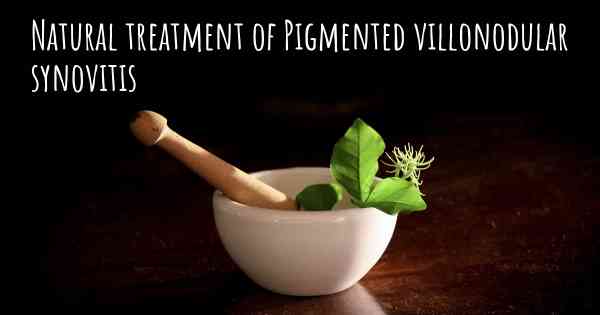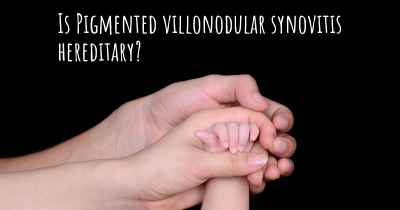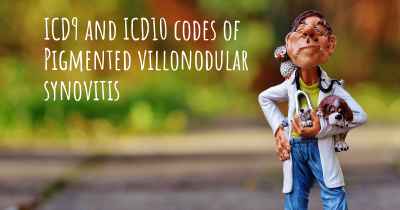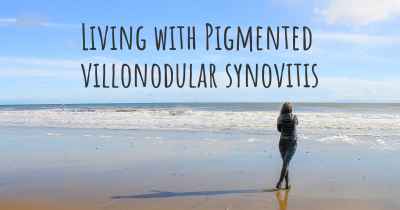Is there any natural treatment for Pigmented villonodular synovitis?
Are there natural treatment(s) that may improve the quality of life of people with Pigmented villonodular synovitis? Here you can see if there is any natural remedy and/or treatment that can help people with Pigmented villonodular synovitis

Natural Treatment for Pigmented Villonodular Synovitis
Pigmented villonodular synovitis (PVNS) is a rare joint disorder characterized by the growth of abnormal tissue in the synovium, which is the lining of the joints. This condition can cause pain, swelling, and limited mobility in the affected joint. While there is no specific natural cure for PVNS, there are several natural treatment options that can help manage the symptoms and improve the quality of life for individuals with this condition.
1. Anti-Inflammatory Diet
Following an anti-inflammatory diet can be beneficial for individuals with PVNS. This diet focuses on consuming foods that help reduce inflammation in the body. Include plenty of fresh fruits, vegetables, whole grains, and healthy fats such as olive oil and avocados. Avoid or limit processed foods, sugary snacks, and beverages, as they can contribute to inflammation.
2. Turmeric
Turmeric is a spice known for its anti-inflammatory properties. It contains a compound called curcumin, which has been shown to reduce inflammation and pain. Incorporating turmeric into your diet or taking curcumin supplements may help alleviate symptoms associated with PVNS. However, it's important to consult with a healthcare professional before starting any new supplements.
3. Ginger
Ginger is another natural ingredient with powerful anti-inflammatory effects. It can help reduce pain and swelling associated with PVNS. You can consume ginger by adding it to your meals, drinking ginger tea, or taking ginger supplements. As with any supplement, consult with a healthcare professional for proper dosage and guidance.
4. Omega-3 Fatty Acids
Omega-3 fatty acids are known for their anti-inflammatory properties. They can help reduce joint pain and inflammation associated with PVNS. Include foods rich in omega-3 fatty acids, such as fatty fish (salmon, mackerel, sardines), flaxseeds, chia seeds, and walnuts, in your diet. Alternatively, omega-3 supplements can be considered under the guidance of a healthcare professional.
5. Exercise and Physical Therapy
Engaging in regular exercise and physical therapy can help improve joint mobility and strengthen the muscles around the affected joint. Low-impact exercises like swimming, cycling, and walking can be beneficial. Physical therapy sessions can provide targeted exercises and techniques to manage pain and improve joint function. Consult with a physical therapist for a personalized exercise plan.
6. Heat and Cold Therapy
Applying heat or cold to the affected joint can help alleviate pain and reduce swelling. Heat therapy, such as warm compresses or heating pads, can help relax muscles and improve blood circulation. Cold therapy, using ice packs or cold compresses, can numb the area and reduce inflammation. Alternate between heat and cold therapy for maximum benefit.
7. Stress Reduction Techniques
Chronic pain and inflammation can be exacerbated by stress. Incorporating stress reduction techniques into your daily routine can help manage PVNS symptoms. Consider practices such as meditation, deep breathing exercises, yoga, or engaging in hobbies that promote relaxation. Finding healthy ways to cope with stress can positively impact your overall well-being.
8. Herbal Supplements
Some herbal supplements may have anti-inflammatory properties and can be considered as complementary treatments for PVNS. Examples include boswellia, devil's claw, and bromelain. However, it's crucial to consult with a healthcare professional before starting any herbal supplements to ensure safety and proper dosage.
While these natural treatment options can help manage the symptoms of PVNS, it's important to note that they may not provide a complete cure. It is essential to work closely with a healthcare professional who can provide a comprehensive treatment plan tailored to your specific condition. Regular medical check-ups and monitoring are necessary to ensure the best possible outcome.








